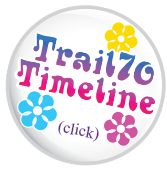History of the “Trail 70”
Model CT70 by Honda Motorcycles
The Honda Motorcycles CT70, a.k.a. “Trail 70,” traces its lineage to the Honda Z series we know today as the Z50. Honda participated in a motorsports-themed amusement park in Tokyo, Japan called “Tama Tech” and in 1961 the company put in service a mini-motorcycle for the children. When riding the mini-bikes around the park individuals were said to look silly, ‘like little Monkeys,’ and the term “Monkey Bike” was born. Honda expanded the popular concept by featuring a ride built upon the mini-bike concept called the “Z100.” The cycle based ride mounted several 5-inch wheel mini-bikes to a ring, having the riders drive around in a circle. Honda first offered a version of these 49cc cycles, the CZ100, for export in 1963. By 1967 the product had evolved to the Z50M which was the first Monkey bike marketed in Japan. Unique features including detachable front fork, small wheels and fold down handle bars allowed the compact motorcycle to be placed in a car trunk, mobile home, airplane, or boat. By 1969 Honda produced the Z50A (built without the detachable fork of the export model) for the US market.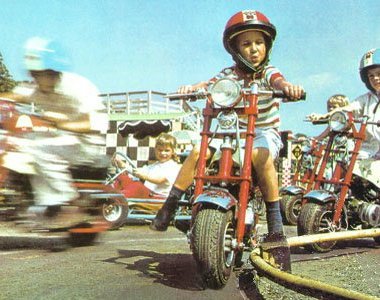
Having success with the “Monkey” concept Honda also introduced another animal, the “DAX” mini-bike. DAX is short for Dachshund or ‘wiener dog.’ The DAX name was a play on the look of the new series “ST” with its distinct “T-bone” hollow body frame, 10-inch tires, and fuel tank under the two person seat. This T-bone frame, being long and stout, made the mini-bike resemble a Dachshund dog. Officially released in 1969 as the “DAX Honda” ST70Z for general export this completely new mini-bike kept with the Z50 tradition of being portable, but with a larger 72cc motor and frame. The original Monkey and Dax series of mini-bikes offered fold down handle bars, a detachable front fork, and two fuel cut-offs.
Offered to the US market, also in 1969, and sold simply as Honda not DAX Honda was the “Trail 70” model CT70. 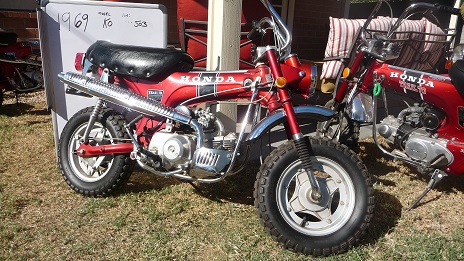
The CT was offered only in a dual-purpose (on/off road) configuration, absent the detachable front fork of the ST of the time. This CT70 was technically known as the ‘CT70 type two’ configuration of the DAX line-up. Honda continued to sell for general export and Japan the DAX Hondas in both a type one (street) and type two (dual-purpose) set ups. The original type one DAX had ‘ducktail fenders.’ 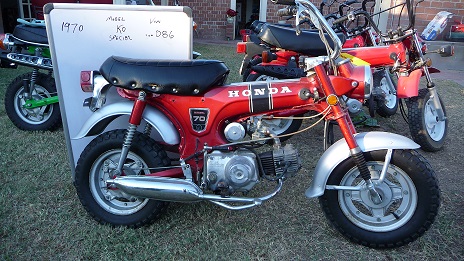
The DAX concept ultimately would expand to include 50cc and 89cc mini-bikes. Although a 50cc ST50 Honda was never offered to the US market for three years, 1972-74, Honda did release the ST90 in the states. With 14-inch wheels and BMX style handlebars the ST90 motorcycle did not sell well and was discontinued.
The company chose to offer the DAX bike in the US as a ‘CT series’ (trail oriented) rather than as the ST series because the CT was already well established in the US. The CT90 or “Trail 90” was introduced here in 1966. The Trail 90 featured a high toque 89cc motor with 4-speed dual-range transmission allowing for 8 gear shifting points, and a unique ‘step-thru frame design,’ similar to that of a girls bicycle frame. The motorcycle was used by hikers, ranchers, and even the US Forest Service. The motorcycle was seen an alternative to a horse in many cases. Building on that solid CT trail reputation Honda introduced the 72cc DAX mini-bike as the Honda “Trail 70” model CT70 in 1969 with a 3-speed semi-automatic transmission. The name “Trail” was virtually the only similarity between the CT90 and CT70. Some model years later Honda would brand the bike as the “mini-Trail” but by the 1991 model the DAX bike in the US was simply called a CT70.
The CT70 series was available in the US market from the years 1969-1982 and 1991-94. Relatively few revisions occurred year to year and all models share the DAX T-bone frame holding a 72cc OHC 4 stroke motor. Notable changes included:
1. 1970 -early switch from plastic to metal brake levers, removed seat bolts under seat, but the Model remained the “KO.”
2. 1970 -late year Honda introduced a 4-speed manual clutch version known as model “HKO” while the KO three-speed remained on the market.
3. 1972 -introduced the K1 and HK1 changing from combination headlight speedometer bucket to a separate speedo and headlight, changed front shock design.
4. 1973 -stopped making the 4-speed model, added mirrors, chromed the ‘head light ears,’ chromed the shock shrouds on the rear, introduced as the K2.
5. 1974 -added turn indicators as the K3 Model.
6. 1975 –final year of the “K” models was the K4.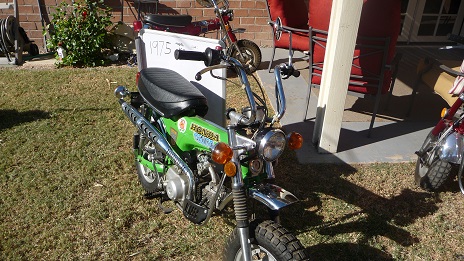
7. 1978 - began to substitute black painted parts for the traditional chrome (some 78’s had a chrome plug guard and rear turn signal bar, some had black), also began removing the ‘buddy peg’ holes on rear axle arm, and changed the carburetor.
8. 1979 -replaced chrome fenders with painted fenders, replaced chrome muffler guard with flat black guard, and discontinued chrome ‘folding’ handlebars in favor of black ‘BMX’ style handlebars, taking away most of the shiny 70’s look of the bike.
9. 1980 -replaced painted metal front fender with a plastic front fender, changed speedometer and ignition switch, and replaced chrome mirrors with black plastic mirrors.
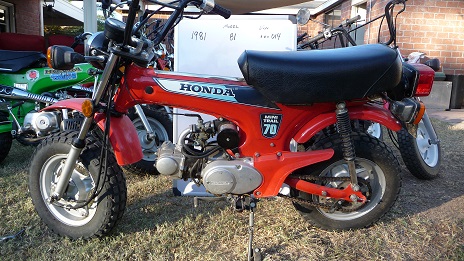
10. 1982 -suspended sales to the US market after the 82 model.
11. 1991 -reintroduced to the US market. Replaced aluminum painted wheel rims, with a white wheel rims, redesigned the front shocks, added larger headlight speedometer configuration, and changed the way the seat mounted.
12. 1993/4 -began adding an additional air recovery device to meet tougher emission control as required in certain markets (primarily California).
13. 1994 -officially the final release year of the CT70 by Honda Motorcycles in the US.
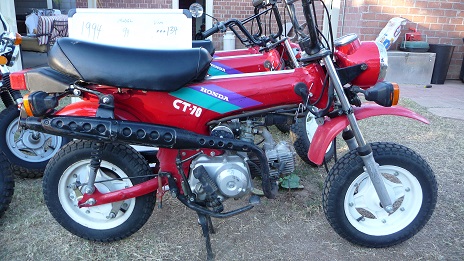
14. 1995 –Honda reintroduced the ST50 (never released in the US) and continued production through 2000.
15. 1998 -most of the DAX Honda patents began to expire, and several manufactures released ‘clones’ of the Trail 70.
The CT70/Trail 70 was wildly popular in the US during the 1970’s. The mid-west and other farm and ranch areas of the US gave huge sales of the models to Honda Motorcycles. Most importantly to Honda, the bike brought ‘middle America’ into the dealer showrooms. With an original MSRP (manufacturers’ suggested retail price) of $ 395 the Trail 70 was about two or three times the price of a Sears, Wards, or Rupp mini-bike, but Honda quality was considered worth the price. Growing up in the 70’s every little boy who grew-up on, went to, or had a friend on a farm knew someone who had a Trail 70. In fact, ask a Biker age 45 to 65 what the first motorcycle he ever road was, and, he will probably say; “Trail 70.” In the 70’s Harley Davidson was a firm in shambles (owned by ‘AMF’), while Suzuki and Yamaha proved little competition to Honda. Kawasaki had a competitive bike named the KV75 but it lacked the chrome, versatility, and quality of a Honda. Kawasaki entered the market about the same time as Honda, 1969, offering the ‘Coyote’ mini-bike which featured the ‘pull-start’ motor similar to the Sears models. The Coyote was a direct competitor to the Honda Z50 and indirectly the CT70, but the mini-bike never gained the popularity of the Honda.
Obtaining motor vehicle title and licensing for the CT70 generally was not a problem in the 1970’s, although most buyers never bothered to license the cycle for highway use. Dealers did give bills of sale or even official titles in some states, but few owners kept track of these documents. By the late 1980’s the market for motorcycles was in flux. Many localities would no longer allow licensing of the CT70 for ‘road use’ due to inadequate lighting (6 volt system), emission standards, limited speed, or simple ignorance of the unique nature of the bike. However, since the cycles were versatile, lasted year after year despite abuse, and were generally purchased for recreational use, the Trail 70 kept a limited but loyal following for years to come.
From the prospective of Honda time did eventually catch-up to this little bike. Although the CT70 has been reported as the second most popular bike (second only to the CB750) Honda has ever released, several factors ultimately would lead to a cease in production for the US market:
1. The rise of low cost high powered BMX style 2-stroke cycles highlighted just how comparably low powered a 4.5/5 horsepower Honda 72cc motor was.
2. Dual purpose bikes all over the US fell out of favor due to safety concerns centering on their elevated seating configurations.
3. Air quality standards would continue to plague the 4 stroke air-cooled designs.
4. The ‘Save Harley-Davidson Tax’ placed greater profitability demands on Japanese motorcycle manufactures.
5. The pending loss of patent protection by Honda meant a complete redesign would be necessary for competitive reasons.
In the early 1980’s CT70 bike sales were nil compared to the earlier years and production for the US market stopped in 1982. Honda Motorcycles gave it one more shot by reintroducing the CT70 in 1991. However, the market had completely changed by that time, and the bike that was once seen as ideally versatile to the 70’s buyer, now seemed dated, and not particularly good for any specific use. 1994 was the last year Honda would sell the CT70 in the US.

